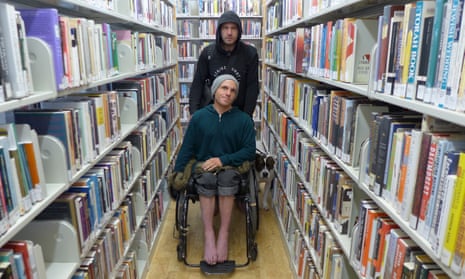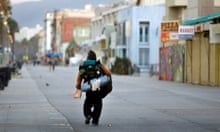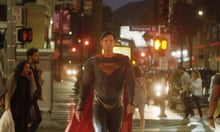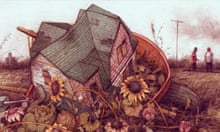The architect presented the landscaping plans for the library at a meeting in December. “It’s really going to be a defensive type of landscape,” she said to community members gathered at the library in San Francisco’s Castro neighborhood.
She enumerated the features that would make the outside of the library a harder place to spend time: railings on walls to prevent sitting, undulating rock formations to prevent encampments, benches with armrests to prevent people from lying down.
A local resident, addressing the room, said tough measures were crucial, complaining that the library is the “destination of choice for the transients that are causing so much trouble in our neighborhood”.
Of all the places associated in the popular imagination with homelessness – park benches, skid rows, the undersides of freeways – libraries are probably low on the list. Yet the Castro branch, like others across California and elsewhere in the western US, is treated by many homeless people as a sanctuary from streets that can be cold, wet and dangerous.
Some residents, however, have urged making libraries or their environs less attractive to homeless visitors.
There has been “a huge increase” in the number of libraries offering homelessness programs since the late 2000s, according to Julie Todaro, president of the American Library Association. “What is continuously upsetting to us is the condition in which people have to exist.”
The allure of libraries for people with no permanent home is obvious. There is no cost to enter. They are warm and safe. They offer internet, electrical sockets, and materials that provide a mental escape from everyday life. Nurses patrol libraries in Pima County, Arizona, while in Salt Lake City, residents opposed plans to open the main branch 24 hours a day, fearing it would become a de facto homeless shelter. San Francisco’s main library, in the city’s downtown area, has a full-time social worker.
The Castro branch, an airy and modern space away from the main tourist drags, stands out for the special place it occupies in San Francisco’s history. It was renamed the Harvey Milk Memorial branch in 1981, three years following its namesake’s assassination. “For 1981, that was huge,” said Daniel Nicoletta, who worked on Milk’s campaigns and in his camera store, and attended the christening ceremony. “To actually get recognition from a civic institution was very significant.”
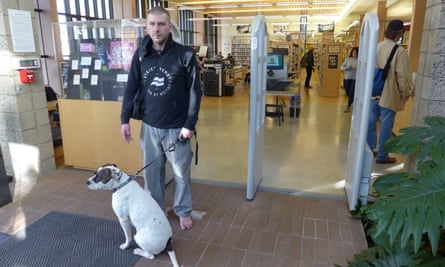
It has a large LGBT selection, displays of gay historical memorabilia, and by the counter there is a photograph of Milk standing on Castro Street, just a few blocks away, which was taken by Nicoletta. He takes a dark view of the landscaping plans, which he argued are “totally against the spirit of Harvey”.
“People sitting on their stoops and communicating and coalition-building is the essence of his vision of a neighborhood,” Nicoletta said.
The proposals, not yet finalized, echo other attempts to make public spaces unappealing to homeless people: jagged rocks under a freeway bridge in San Diego, and iron spikes on planter boxes outside a San Francisco supermarket.
Local homeless people commonly pitch tents across the street from the library or seek shelter under its large overhangs. Some are said to have climbed on to the roof at night until access was restricted.
“I think it’s a terrible idea,” Shane Berry, 31, said of the defensive architecture. “This is all we have. Where else do they want us to go?”
Berry was hanging out at a popular spot for the area’s homeless residents: a low wall around the parking lot. He originally came to San Francisco because his conservative Texas family rejected his sexuality. He said he became paralyzed in a 2015 car accident and has a meth addiction.
“Being gay draws me here,” he said of the area. “It gives me a level of comfort knowing there are like-minded people around me.”
He uses the library to charge his phone, though he does not borrow books because he worries he’ll lose them in an encampment sweep. He sleeps in an alley by the branch, suffers from infections linked to sitting in his wheelchair, and lacks sanitary conditions when he needs to change his catheter.
“I know one thing concerning my situation,” he said. “Something’s going to give or I’m going to die out here.”
Local residents, however, describe a litany of problems in the streets around the library that they associate with homeless people: used needles, graffiti, trash and human waste, which a neighbor said on one occasion was smeared on a garage door.
“There are some people who are homeless in the neighborhood that are extremely respectful – they will sleep and when they get up in the morning they’ll take all their stuff with them,” said Mark Silva, a neighbor. Others “treat it like their toilet, treat it like their trash bin”.
Carolyn Thomas said her husband, who is 72, had pondered moving elsewhere. To her, the library feels off-limits. “I don’t go in any longer. What makes me afraid when I walk by are people yelling, shouting, fighting amongst themselves.”
The landscaping is one part of the city’s response. Recently it put up temporary fencing around parts of the library to prevent people from striking camp there.
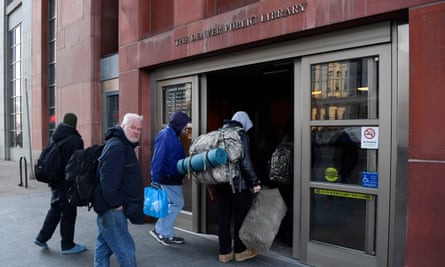
A district manager for the library system, Rebecca Alcala-Veraflor, emphasized that the branches welcome those seeking information of any kind, including “where to find shelter, where to find a food pantry”.
Still, patrons must observe a code of conduct. Sometimes, in contravention of it, they bathe or take drugs in the Castro library restroom. On a recent afternoon, a staffer rapped with her fist on a table next to a sleeping man. “Sir, if we have to wake you up one more time we’re going to ask you to leave,” she said.
Perhaps unsurprisingly, given the burdens placed on the library, a member of a social services team is stationed at the facility several hours each week. Norman Rutherford acknowledged how far the Castro branch is from the stereotypical notion of libraries as quiet places to read a book. “People have really different views of what’s appropriate for a library,” he said. “It’s not my role” to choose among them.
When it started to hail outside, he went to check on a group of about 10 people sheltering under tarps and blankets in the lee of the building. They all declined his offers of assistance. After he left, Kimberly Reeves, 20, who had pink hair, blue eyes and a punky leather jacket, said she knew the situation was fraught.
“I feel like a lot of people straight up hate people who are homeless,” she said. Then she gestured to the detritus that had been left behind: an empty can of spray paint, a balled-up fleece, handprints on the side of the library from a substance that resembled blood but she said was not.
“I can’t really blame them. Look at this trash,” she added. “It’s like our house without walls.”
